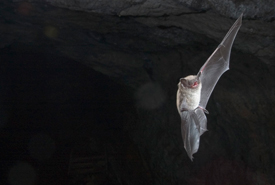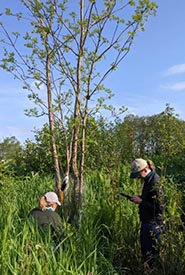The bats are calling

Little brown myotis (Photo by Brock Fenton)
With white-nose syndrome on the rise, the Nature Conservancy of Canada's (NCC's) Newfoundland and Labrador team headed to three different properties to monitor for bat presence, specifically for little brown myotis and northern myotis. These at-risk bats were just recently listed as endangered in the province of Newfoundland and Labrador.
Since 2017, white-nose syndrome has made life a nightmare for the bat population in the province and across the country. This deadly, non-native fungal disease affects bats during hibernation; waking up hungry in winter is no fun for the animals. The steep declines in the population (in some areas estimated to be about 90 per cent) and having only one offspring a year make it challenging for the bat population to grow in size.
Thankfully, there are ways to help these wonderful flying mammals. The monitoring process for Newfoundland and Labrador involved visiting three nature reserves: Black Ash on June 7, Barachois Brooke the next day and Grand Codroy Estuary on June 9.
As NCC’s acting stewardship coordinator for Newfoundland and Labrador, Jennifer Sullivan talks about the challenges of finding the right habitat to record bat activity successfully. Listening to bats using acoustic monitoring devices helps identify their activity in an area. Since monitoring devices can pick up a lot of unwanted noise, the devices are installed in open areas rather than dense and branch-heavy lands. Fortunately, little brown myotis enjoys open habitats with calm bodies of water in case they need to take a sip.
Jennifer heads the monitoring and field work for NCC’s nature reserves in the province, including property restoration and species at risk monitoring. In addition, she works with local communities and partners and hosting events in the community.

Jennifer and Gabrielle bat monitoring, NL (Photo by NCC)
Now an advocate for bats, Jennifer recalls an interesting memory from her childhood. Fishing one evening with her dad, she remembers seeing mayflies emerging from the water. As the flies came out, a large group of bats swooped to catch them, some getting very close to Jennifer’s head. These bats are now threatened, and Jennifer believes that any research on these species will be critical to helping their population.
Monitoring the bats has provided great learning opportunities for Jennifer. After attending an acoustic bat monitoring webinar hosted by the North America Bat Monitoring Program in February 2021, Jennifer’s interest in the topic grew into her own project. Like a true go-getter, and with the help of Jessica Humber, provincial wildlife researcher, Jennifer found ways to borrow monitoring devices and other types of equipment from NL Provincial Wildlife Division. This support is a great help to the project. The equipment included acoustic monitoring devices and microphones. Although these stationary devices help determine species richness, they cannot identify the exact number of bats for an area.
If you’re wondering how you can help bats, keep your distance from their hibernation habitat, caves or mines to prevent the accidental spread of white-nose syndrome. In summer, you can also join bat monitoring programs as a citizen scientist. Report a sick or dead bat to the Atlantic Veterinary College. For more information about what you can do to help these magnificent creatures, check out the Canadian Wildlife Health Cooperative – Bat Health Resources.
Although a lot of planning gets done ahead of travelling, nobody can predict how field days really turn out. Thankfully, the day spent at Black Ash Nature Reserve did not introduce too many challenges for the team. The large open bodies of water, tall limbs and branches made the area ideal for installing devices. Unlike Black Ash, the Barachois Brook property contained alder thickets, which meant fewer trees and more shrubs. This sort of environment was not as easily accessible for monitoring as Black Ash. The silver lining is that Jennifer can now share her experiences with other staff, either in the form of safety talks or tips and tricks.





